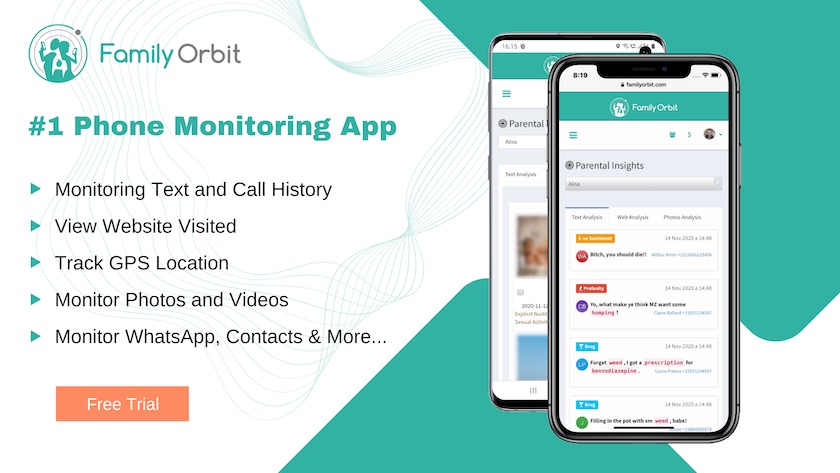Texting has become an integral part of teenage communication in today’s digital age. Recent statistics reveal that on average, teens send and receive over 100 text messages daily. With the rise in mobile phone usage, texting has become an efficient way for teens to stay in touch with their friends and family.
However, as technology continues to advance, the question arises: Should texting be allowed in classrooms?
In this article, we’ll look into the pros and cons of allowing texting in schools as well as offer tips for parents on monitoring their children’s texting habits using Family Orbit.
Statistics on Texting among Teenagers
Let’s take a closer look at some texting statistics among teenagers. According to a survey conducted by Pew Research Center, 88% of American teenagers own a mobile phone, and 90% send and receive text messages regularly. Furthermore, girls tend to send more messages than boys do, sending an average of 140 per day compared to 110 daily for boys.
According to Common Sense Media’s study, teenagers spend an average of 9 hours daily on their mobile devices–with much of that time dedicated to texting. With such high usage rates, it’s no surprise that texting has become an integral part of teenage communication.
Texting can be a convenient way for teens to stay connected with their friends and family, but excessive usage may have negative repercussions such as decreased academic performance or increased anxiety.
As parents and educators, it’s essential that we comprehend the effects of texting on teenagers and find ways to monitor and regulate their usage accordingly.
Should Texting Be Allowed in Classrooms?

Texting in classrooms has long been a contentious debate between educators and parents. On one side, proponents argue that texting allows for increased communication and collaboration among students; they can share notes, ask questions, and work on group projects without disrupting the class.
Conversely, opponents contend that allowing texting can be distracting and detrimental to learners’ learning experiences.
Ultimately, the decision to allow or prohibit texting in classrooms should be determined according to each classroom’s individual needs and circumstances.
Here are some factors that should be taken into account:
Class Size and Subject Matter
When considering whether texting is appropriate for a classroom setting, the size of the group and the subject matter should be taken into consideration.
Larger classes tend to have less disruption from texting than smaller ones where distractions are more obvious.
Furthermore, certain subjects may lend themselves better to texting than others – for instance, language classes where students practice their writing skills more than in math classes where handwritten calculations may be required.
Classroom Policies
It is essential for teachers to establish clear policies regarding the use of mobile devices in the classroom, communicate them to students, and enforce them consistently. Furthermore, teachers may look into using classroom management software that enables them to monitor and regulate mobile device usage during class time.
Student Needs
It is essential to consider the individual needs of students when deciding whether or not texting in classrooms should be allowed. For instance, those with disabilities or learning differences could benefit from assistive technology like speech-to-text software, which requires using a mobile device.
Overall, when deciding whether or not texting in classrooms should be allowed, one must carefully weigh the potential advantages and drawbacks as well as take into account each classroom’s individual needs and circumstances.
Pros of Allowing Texting in Classrooms

- Promoting communication and collaboration: Texting allows students to stay in touch and work together more efficiently on group projects outside of class time. This makes texting especially helpful in such instances.
- Enhances Engagement: Texting can be an effective tool to engage students who may feel shy or hesitant to contribute to class discussions. By providing them with the ability to communicate via text, students may feel more at ease expressing their opinions and asking questions.
- Provides a Record of Communication: Texting can serve as a record of communication that is beneficial for both students and teachers alike. For instance, students can refer back to text messages for clarification on class material, while teachers can utilize them as an instrument to assess student participation in class activities.
- Texting Offers Quick Communication: Texting can be an efficient and speedy way to share information or ask questions during class time. This is especially helpful for students who may require clarification on a certain concept or assignment.
Cons of Allowing Texting in Classrooms

- Distracts From Learning: Texting can be distracting for both sender and recipient, diverting attention away from the lesson at hand. Even when students are texting about class-related matters, typing on a phone still serves to take some focus away from studying.
- Disruptive to the Class: Texting can be disruptive to a classroom, especially if students are discussing non-class topics. The sound of notifications and typing may distract other students and disrupt their concentration in class.
- Enables Cheating: Texting can be used as a method for cheating, such as sharing answers or copying homework. Allowing texting in classrooms may make it easier for students to engage in this behavior, which could have negative repercussions on their academic performance and overall learning experience.
- Difficult to monitor: It can be challenging for teachers to monitor and regulate texting during class time. This could lead to misuse or abuse of mobile devices, distracting other students and disrupting the class environment.
- Encourages Multi-tasking: Allowing texting in classrooms may encourage multi-tasking, which could have detrimental effects on students’ academic performance. They may be more apt to engage in distracting activities on their phones rather than paying full attention to the lesson at hand.
- Increases Screen Time: Allowing texting in classrooms can significantly increase students’ screen time, which has been linked to various negative health effects like eye strain, headaches, and sleep disturbances. Texting may add to an already high level of screen time for many students – particularly those who use their phones excessively outside school hours. Allowing texting may contribute to this already high level of screen time for many.
Overall, while texting in classrooms may have its advantages, it’s essential to consider its potential drawbacks as well. Teachers and parents should carefully weigh both pros and cons before deciding whether or not to allow texting during class time, and they should establish clear policies regarding mobile device usage during instruction.
What Can Parents Do to Monitor Texting Activity?

Technology continues to advance and texting has become an essential form of communication for teenagers. However, with this increased usage comes the responsibility for parents to monitor their children’s texting habits in order to protect their safety and well-being. Here are some tips for parents on monitoring texting:
Use Parental Control Software
One of the simplest ways to monitor your child’s texting activity is with parental control software like Family Orbit. This program enables parents to keep an eye on their kids’ texts, call logs, and social media activity in real time. Furthermore, Family Orbit also features a GPS tracker so parents can monitor their child’s location in real time.
Establish Ground Rules
Establish firm expectations regarding mobile device usage, such as when and where texting is allowed. Encourage your children to use their devices responsibly and with consideration for others. Setting ground rules helps monitor your child’s activity while protecting their safety by providing clarity around potential risks.
Talking with Your Children
Have an honest and open dialogue with your children about the risks and advantages of texting, and encourage them to reach out if any issues or worries arise. Talking with your kids will give you insight into their habits as a user and allow you to monitor their activity more efficiently.
Monitor Your Child’s Behaviour
Keep an eye on your child’s online and offline behavior. If you notice any changes in their attitude or if they seem to be spending too much time texting, it may be time for an intervention.
Model Responsible Behavior
Set an example for your children by using mobile devices responsibly and respectfully. Doing this will help them develop healthy habits and attitudes toward technology.
Educate Your Child About Online Safety
Talk to your children about online safety and the potential dangers of texting. Teach them how to be cautious when communicating with strangers, and never share personal information.
Set Time Limits
Set limits on how long your child is texting each day to prevent excessive use and ensure they have enough time for other activities such as homework and physical activity.
Monitor Social Media Activity
Be mindful of your child’s social media usage, as this can give you insight into their texting habits. Make sure they use social media responsibly and aren’t engaging in any inappropriate behaviors.
Establish Trust
Foster a relationship of trust with your child so they feel confident coming to you if there are any problems or worries. Doing this can help monitor their texting habits more efficiently and guarantee their safety.
Encourage Face-to-Face Communication
Encourage your child to communicate with friends and family face-to-face, rather than solely via texting. Face-to-face interactions are important for social and emotional development while helping prevent excessive texting.
Conclusion

Parents can monitor their children’s texting habits and help ensure their safety in an increasingly digital world. Encourage your child to communicate openly with you about his or her mobile device use and establish clear expectations and guidelines for its appropriateness.
Texting among teenagers has become a contentious topic, with both potential advantages and drawbacks to allowing it in classrooms. While texting can promote communication and collaboration, it also distracts and disrupts students. Ultimately, the decision on whether to allow or prohibit texting should be determined according to each classroom’s individual needs and circumstances.
Texting in classrooms has its advantages, but it’s essential to weigh the potential drawbacks and make an informed decision that meets each classroom’s unique requirements. Parents can take steps to monitor their children’s texting habits with tools like Family Orbit, helping guarantee their safety and well-being in today’s increasingly digital world.
- Monitor Calls & Text Messages
- View Photos and Videos
- Location Tracking & Geofence
- Monitor WhatsApp & Kik
- Detect & Alert for Inappropriate Activities
- Monitor Websites Visited
- Compatible with Android and iOS

![The Pros and Cons of Allowing Texting in Classrooms [Are we ready?]](https://www.familyorbit.com/blog/wp-content/uploads/2023/03/texting-in-classeroom-is-it-good-idea-809x485.jpg)